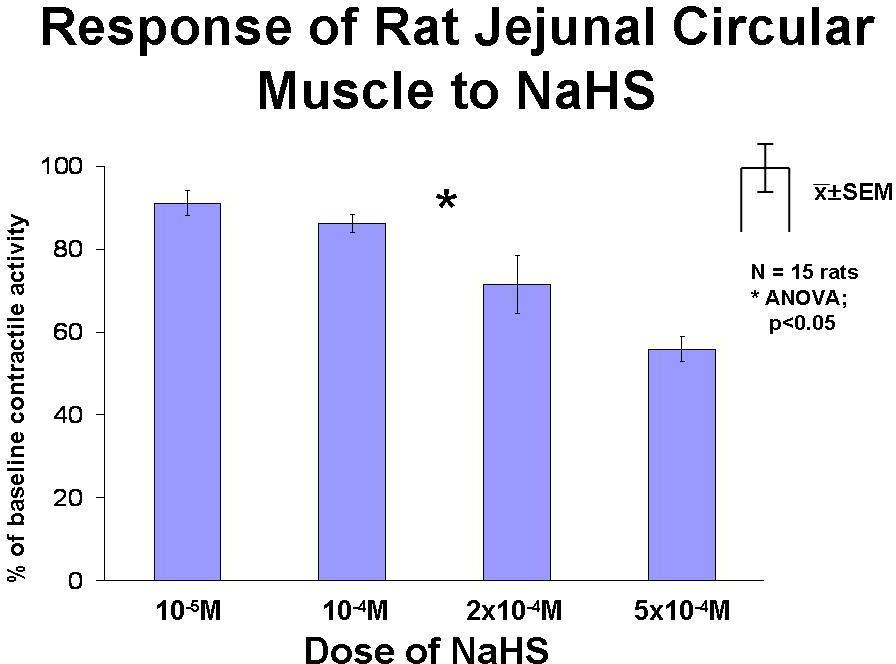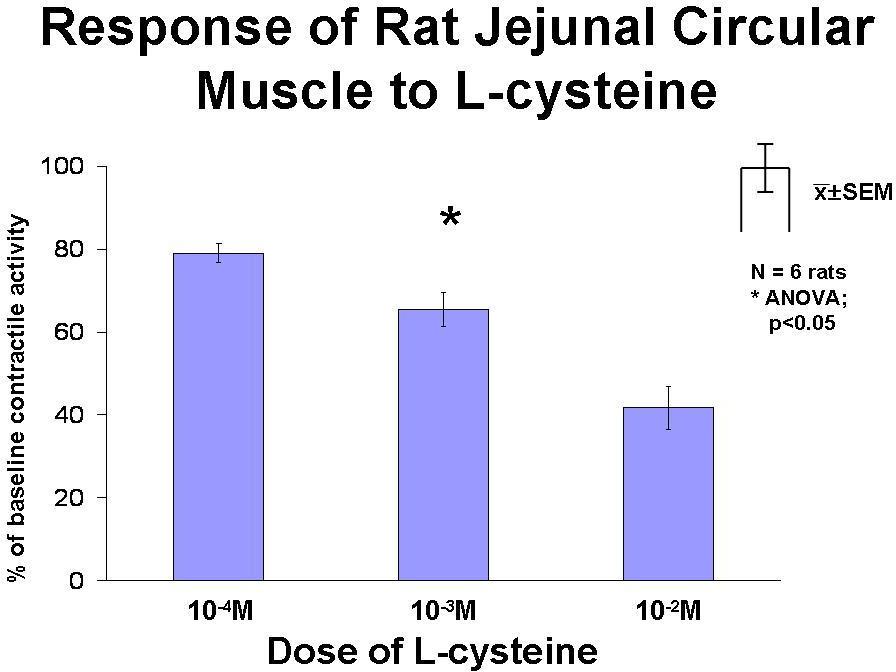Role of Hydrogen Sulfide in Contractile Activity in Circular Muscle of Rat Jejunum
Munenori Nagao*1,2, Judith a. Duenes1,2, Michael G. Sarr1,2
1Surgery, Mayo Clinic, Rochester, MN; 2Gastroenterology Research Unit, Mayo Clinic, Rochester, MN
BACKGROUND: Endogenous hydrogen sulfide (H2S) appears to be a new gasotransmitter that modulates small intestinal motility, but mechanisms of action of H2S are unknown in gut smooth muscle. AIM: To determine effects and mechanisms of action of H2S on contractile activity in circular muscle of rat jejunum. METHODS: Jejunal circular muscle strips from Lewis rats were mounted in temperature-controlled tissue chambers to measure contractile activity. Sodium hydrosulfide (NaHS) was used as an exogenous donor of H2S yielding physiologic levels of H2S of 10-5, 10-4, 2x10-4, and 5x10-4 M, resp. We evaluated effects of NaHS on spontaneous contractile activity and after precontraction with bethanechol (10-4 M). L-cysteine (10-4, 10-3 and 10-2 M), the substrate for endogenous production of H2S via H2S-producing enzymes, was also evaluated. We used atropine (10-7 M), phentolamine (10-5 M), and propranolol (5x10-6 M) together to establish non-adrenergic/non-cholinergic (NANC) conditions, and in separate experiments tetrodotoxin (10-6 M), capsaicin (10-5 and 10-4 M), L-NG-nitro arginine (L-NNA; 10-4 and 10-3 M), glibenclamide (10-5 and 10-4 M), apamin (10-6 and 5x10-6 M) , and calyculin A (10-6 M) to study involvement of the NANC and enteric nervous system, primary visceral afferent nerve fibers, nitric oxide, K+ATP channel, K+Ca channel, and myosin light chain phosphatase activity, respectively, in mediating the inhibitory action of H2S. Motility was quantitated as area under the contractile curve and used to compare the effects. RESULTS: NaHS exhibited a marked, dose-dependent inhibitory effect (Fig 1) on spontaneous contractile activity (p<0.05); threshold dose 10-4 M, ID50 (50% inhibitory dose) = 3x10-4 M. However, surprisingly, NaHS did not inhibit bethanechol-stimulated contractile activity. L-cysteine also exerted a dose-dependent inhibitory effect on contractile activity (Fig 2) (p<0.05). Establishment of NANC conditions, blockade of all neural activity by tetrodotoxin, exposure to capsaicin (block visceral afferents), L-NNA (block NO production), glibenclamide (block K+ATP channels), or apamin (block K+Ca channels) had no effect on (i.e. did not block) the inhibitory response to 5x10-4 M NaHS. After exposure to calyculin A (block myosin light chain phosphatase), the inhibitory effect of NaHS was prevented. CONCLUSIONS: H2S at physiologic concentrations and L-cysteine inhibit contractile activity of rat jejunal circular muscle. The inhibitory effect of H2S on jejunal circular muscle does not appear to be mediated via K+ATP channels as in the vascular tree or by the more classic pathways via the enteric nervous system, a nitric oxide pathway, activity of visceral afferent nerve fibers, or K+Ca channels but rather via myosin light chain phosphatase. (Support RO1-DK39337 [MGS])
Fig 1
Fig 2
Back to 2011 Program



